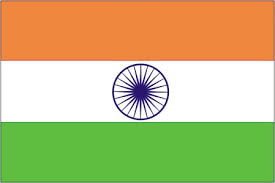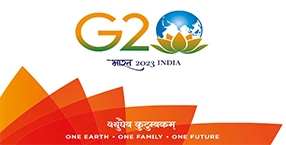Cultural Relations
Soon after Vasco da Gama reached India, the Augsburg trade houses established links with the Portuguese in view of the discovery of sea route around Africa to India to pursue business opportunities for trade in spices and precious stones. In 1505, Balthasar Springer, an Austrian businessman from Tyrol, traveled with the third Portuguese fleet to India. He wrote a book ‘Meerfahrt’ about his travels in 1509.
Towards end of the 17 century, several smaller European powers with access to the sea, such as Denmark, Sweden, the Austrian Netherlands and Prussia looked overseas following old Spain, Portugal, England, the Dutch Republic and France, which meanwhile had expanded to become world powers.
The trade from Ostend in the Austrian Netherlands to India and China started in 1715. Some private merchants from Antwerp, Ghent and Ostend were granted charters for the East-India trade by the Austrian govemment that had recently come to power in the Southern Netherlands. Between 1715 and 1723, 34 ships sailed from Ostend to the Malabar or Coromandel coast, Surat, Bengal and China. Those expeditions were financed by different international syndicates comprising Flemish, English, Dutch and French merchants and bankers. The mutual rivalry between them however weighed heavily upon theprofits and this resulted in the foundation of the Ostend East-India Company, chartered by the Austrian emperor in December 1722. The company also possessed two factories: Cabelon on the Coromandel coast and Banquibazar in Bengal.
Following political pressure from rival colonial powers, in 1727 the charter of the company was suspended for 7 years and in 1731 the 2 nd treaty of Vienna ordered the definitive abolition. The very last ships sailing for the company were the two “permission-vessels” that left in 1732 and were a concession made in the second treaty of Vienna. The company continued to operate as a bank for trade with India and China until 1745, since the Indian operations continued up to the middle of the 18th century. In 1775 a Dutchman Wilhelm Bolt founded an Austrian East-Indian Trading Company and established trading posts on the coast of Southeast Africa and in India (Malabar Coast 1778), Nicobar Islands (1778-82). Bolt commanded an Austrian ship ‘Joseph und Theresia’ and sailed to India. He reached the Nicobar Islands in 1778 and named one of them as ‘Theresia’ in honour of Queen Maria Theresia. The company was transformed into an Asian Trading Company headquartered in Trieste in 1780 and dissolved in 1785.
The Ottoman Empire had barred European commerce from the Red Sea since the 16th century. Austria, as well as England, France and Russia, sought in the 1780s and 1790s to persuade the Ottoman government to allow European ships to use the port of Suez and carry on trade through the Red Sea to India. European trade was not permitted in the Red Sea until the 19th century.
In 1892, Archduke Franz Ferdinandvisited India during his trip around the world (traveling overland from Bombay to Calcutta) and the original account of his travels is also a subject under research and publication.
India-Austria Cultural Links
IIndian art, culture and ideas reached Austria through the voyages of businesspersons and others. Some of the remarkable works of art created in India can be found in Austria today. The Museum of Applied Arts in Vienna has the largest collection in the world of illustrated manuscripts from the Hamza Nama (1562-1577) which was crafted for Emperor Akbar of India in the highest tradition of Indo-Persian painting. In the early 18th century, Queen Maria Theresia decorated one of the rooms in the magnificent Schoenbrunn Place with original Mughal miniatures, which are currently under restoration at the Austrian National Library.
The Austrian tradition of Indology began in a period renowned for its distinguished Philologists and Archaeologists (between 1825 and 1920). Just as elsewhere in Europe, the Austrian Indology tradition was initially intimately connected with linguistics and philology. The groundwork was done by Prof. Anton Boller who began teaching Sanskrit at Vienna University in 1845 and held the Chair for Linguistics and Sanskrit. The discipline reached its first highpoint in 1880 with the foundation of an independent Chair for Indology. As an expert in Hindu Law literature, poetry and Indian Epigraphy, Prof. Bühler achieved world-wide renown among the Indological academia. During his time as Chairholder for Indology, he turned Vienna into a centre of Indology Studies. The Chair for Indology was interrupted for a brief period from 1938 to 1955, after which it became an independent Department with new premises. Today it is known as Institute for South Asian, Tibetan and Buddhist Studies at University of Vienna.
The Institute for South Asian, Tibetan and Buddhist Studies at University of Vienna has organized lectures and exhibition on Ramayana art. The Institute also hosted Prof. Abhijit Ghosh of Jadhavpur University, and Prof Saroj Vidyadhar Bhate from Pune University whose visits were sponsored by ICCR. The Institute has been active in organizing lectures, exhibitions etc in joint collaboration with the Mission.
Between 1840 and 1844, Karl Alexander Freiherr von Hügel’s (Viennese diplomat and explorer, who travelled extensively in Asia from 1830-1836) main work Kaschmir und das Reich der Siek (Cashmere and the Realm of the Sikh) was published in Stuttgart in four volumes. He brought back a collection for objects which can be found in Austrian museums today.
Archduke Ferdinand Max supported the most ambitious enterprise ever undertaken by the Austrian navy, the circumnavigation of the globe by S.M. Novara between 1857 and 1859. Under the command of Captain Freiherr von Pückh, it was manned by 345 officers and crew; seven scientists were also on board. The team took back extensive specimens from their voyages, including those from India. The Austrian museums have vast collections of botanical, zoological (26,000 specimens alone) and ethnological objects brought back. During their stay in Madras (Jan-Feb, 1858), the team witnessed religious festivals. On Feb 23 1858, the Novara reached the Nikobar Isles. They stayed there for a month before proceeding for Singapore.
Karl Alexander Freiherr von Hügel (1796, Regensburg – 1870, Brussels) became one of the great early travellers around Asia, after serving in the army. Christoph von Fürer-Haimendorf (early 1900s) taught ethnology at the University of Vienna before he started extensive fieldwork among the Nagas of Assam, northeast India. After teaching at the Department of Anthropology at the University of London, he continued his exploratory activities in the Himalaya region. Robert Heine-Geldern (1885 Grub, – 1968 Vienna) is regarded as the founder of modern Southeast Asian ethnology. He taught ethnology and archeology of India and Southeast Asia, first in Vienna and then in the USA (1938-1949). In costly expeditions he explored the continent and carried out scientific and ethnographic studies. Rudolf von Leyden (1908 Berlin – 1983 Vienna) travelled to India as a geologist. Pursuing his artistic inclinations he founded the “Leyden Commercial Art Studio” and remained employed in Indian enterprises for 40 years. He left the Museum a “world of Indian playcards”. René von Nebesky-Wojkowitz (1923 Groß Hochschütz – 1959 Vienna) was private lecturer for ethnology, specialising on Tibetology and as curator he supervised this department of the museum. For several years he pursued explorations in Kalimpong/ Sikkim and in Nepal. From this period date his basic works about Tibetan popular religion and the Tibetan mountain cults.
India ‘s philosopher-poet and Nobel Laureate Rabindranath Tagore visited Vienna twice – first in 1921 and then again in 1926. On his first visit he delivered at the University here a famous lecture titled “The Religion Of The Forest”.
In 1932 Subhas Chandra Bose, one of India’s great patriots, came to Vienna and established an India-Central European Society for the promotion of commercial and cultural co-operation between India and the countries of Central Europe foreshadowing, prophetically, present-day co-operation with Austria as an important member of the European Union.
Reputed artistes of India and Austria have performed in each other’s countries for the past several decades. The Indian mission, in cooperation with the Indian Council for Cultural Relations (ICCR) and local organisations, has actively hosted a number of Indian cultural performances (dance, music), organised art/photographic exhibitions. In recent years, renowned Kuchipudi dancers Raja and Radha Reddy, martial arts performers from Kerala, Monish Nayak Kathak Dance Group, Pt. Bholanath Mishra Indian vocal music, Rajasthani folk dance group are among the artistes sponsored by the Indian Council for Cultural Relations, who have performed in Vienna. ICCR also sponsored the visit of twenty children from India to visit Austria to jointly perform choral music with the Vienna Boys Choir in June 2007. Apart from these, the Mission has also recently organized dance recitals by Ms. Jyotsna Shourie and group and Hindustani vocals by Ms. Shikha Ganguly.
Austria-India Association
TThe Austria-India Association was founded over 40 years ago in 1963 by Prof. Arnold KEYSERLING. Although there had been some a few Austria-India Friendship Groups earlier, Prof Keyserling founded the first registered Austria-India Association. The Association started by making efforts to popularize Indian dance and music in Austria. Through such efforts renowned artistes like Ravi Shankar, Ali Akbar Khan and Bismillah Khan – performed in Austria for the first time. Since then a number of famous Indian artists such as Zakir Hussain, Anoushka Shankar, Zubin Mehta and Amjad Ali Khan have been performing in Vienna on commercial terms. Mrs. Krishna Sahi, Minister of State for Industry was the chief guest for the celebrations to mark the 30 th anniversary of the Association in 1993. The 40 th anniversary of the Association was celebrated in November 2003 with cultural events and a seminar on Indian IT sector.
The Austria-India Association has held lectures-exhibition on Indian folk art and paintings, Odissi and Bharatnatyam dance workshops, book exhibitions, film festivals at various venues in Austria. The President of the Austria-India Association is Dr. Radha Anjali who is a well-known Bharatnatyam danseuse in Vienna and runs an Indian classical dance school in Vienna, “Natya Mandir”.
Indian Associations
VVarious Indian Associations such as the Swami Madhavananda World Peace Council, World Malayalee Council, Hindu Mandir Association, Gurudwara Sikh Association, Kerala Samajam Vienna, Vienna Malayalee Association, Kerala Cultural Society, Indian Sports Club etc are active in organizing socio-cultural programmes throughout the year. The Indian community actively engages itself in celebrating Indian cultural and religious festivals in Austria.















